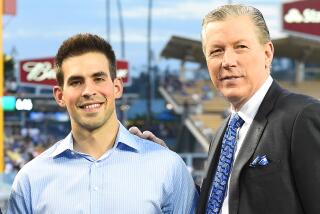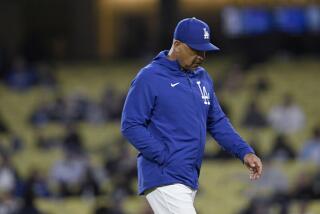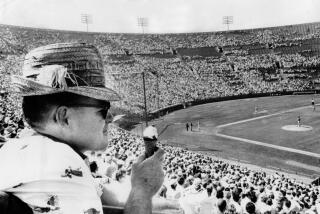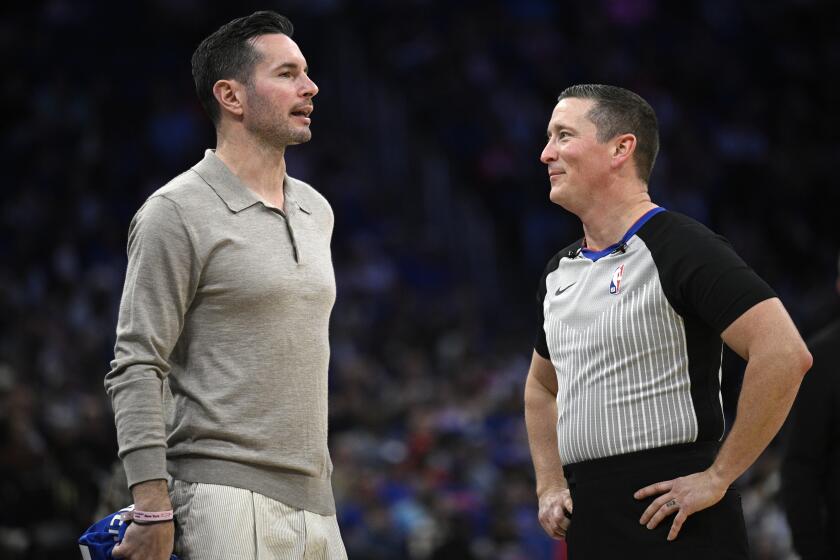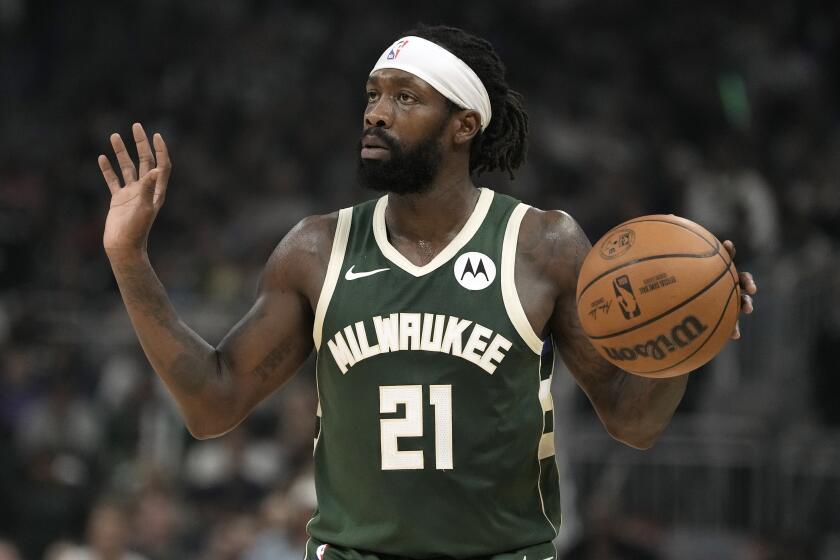Coliseum left a lasting impression
To my youthful eyes, the Coliseum, with its dull gray exterior and looming presence, didn’t seem to offer much in the way of enjoyment when I first saw it on a sunny, summer day in 1958.
That quickly changed as my father led me up stairs that seemed to reach to the sky for my first Dodgers game.
I remember walking down the long, dark tunnel at the top of those stairs. There was light at the end of that tunnel, offering the promise of something special.
I had never been to a professional or collegiate game before in any sport, so this was a grand spectacle to me. The grass seemed so green, the Dodgers uniforms so white, the cavernous stadium so huge.
But in a way, although it was far more vivid and breathtaking than I had imagined, the whole scene also seemed quite familiar, sort of like watching a movie after having pictured the characters by reading the book.
My primer for Dodgers baseball was the words of Vin Scully.
I had watched the Los Angeles Angels of the Pacific Coast League on our black-and-white television and loved Steve Bilko, the burly first baseman with the home run swing. Fifty-five home runs in 1956 and 56 in ’57. He was my Babe Ruth. Who needed the big leagues?
When the Dodgers arrived in 1958, however, I was entranced by Scully.
You have to remember, back in those dark ages of telecommunication, the Dodgers televised only nine regular-season games, those played in San Francisco.
So radio was king and Scully quickly came to rule the L.A. airwaves, giving listeners a word’s-eye view that captivated the city. His mastery of the language, knowledge of the game and attention to detail made you feel as if the Dodgers were a new family that had moved in down the block, one you rapidly came to know as if they were old friends.
Now I was seeing those friends in person. We sat in the upper reaches of the Coliseum down the right-field line. From there, the distance from home plate to the left-field seats seemed even shorter than advertised at 250 feet. The notorious left-field screen appeared higher than 42 feet. The vast territory in right and right-center looked like a cow pasture.
I didn’t care. I ignored the baseball purists who labeled the setup -- a square baseball diamond in a football oval -- a joke. I wasn’t concerned with Don Drysdale’s anger over pop fly home runs to left or Duke Snider’s frustration at towering drives that died in right.
What did I or my friends know? We had never seen Ebbets Field. Yes, baseball in the Coliseum was an adventure, but it was our adventure, our unique brand of baseball.
We had Wally Moon, who came along in 1959 and perfected an inside-out left-handed swing that could turn routine fly balls into home runs labeled “Moon shots.”
Cheap?
Not in our box scores.
We had Sandy Koufax, who didn’t worry about standing on the mound in the shadow of that screen. He just blew batters away, when he wasn’t blowing the game because of his lack of control. It wasn’t until 1962, when the Dodgers moved to Dodger Stadium, that he became The Sandy Koufax, a pitcher for the ages.
We had in excess of 78,000 fans come out opening day, more than 90,000 for each of three World Series games in 1959, and 93,103 for an exhibition game against the New York Yankees to benefit paralyzed former catcher Roy Campanella. It was the largest crowd to ever watch a baseball game until today.
So who cared if much of the rest of the baseball world disapproved of our wacky ballpark?
In my first game, I saw the Dodgers play the Cincinnati Redlegs, then their official team name. In my mind, the stadium was packed, although a check of the box score shows only 8,744 paid their way in on that Wednesday afternoon.
When the first batter, Cincinnati second baseman Johnny Temple, hit a line-drive single to right against Dodgers starter Stan Williams, my dad introduced me to another ritual that would become a part of every baseball outing, the scorecard. He showed me how you can record every at-bat and keep a precise record of your experience.
How cool. I saved the scorecards of every game I attended, even though they were torn from being banged on the seats, brown with soft-drink stains and red with ketchup.
I got an extra bonus that first game. Bilko, by then a Dodger, homered over the left-field screen, reinforcing my naive view that this was one of the great home run hitters of all time.
The Dodgers lost that game, 8-7, but I wasn’t discouraged. My father had opened up a whole new world for me. I’d be back.
And back I came many times over the four years the Dodgers called the Coliseum home. When I returned with my friends, I learned to maneuver around the place. We would buy the cheap seats at the top and, every inning, move down a few rows until, by the ninth inning, with the kindly indifference of big-hearted ushers, we were in the front row near the dugouts.
It was there I got my first autograph from a smiling Ernie Banks as he left the field.
Sometimes we would sit in left-center where you could yell through the screen at the outfielders who, by necessity, were so close you could almost touch them. We assured Willie Mays his hated Giants would lose and implored Wally to hit a Moon shot just for us.
When Dodger Stadium opened, the baseball world praised the state-of-the-art facility. It was everything a baseball stadium should be.
But it wasn’t the Coliseum.
More to Read
Get our high school sports newsletter
Prep Rally is devoted to the SoCal high school sports experience, bringing you scores, stories and a behind-the-scenes look at what makes prep sports so popular.
You may occasionally receive promotional content from the Los Angeles Times.
